Kathy Lynn Emerson's Blog, page 51
February 20, 2017
Boring Can Be Bliss!
Dorothy Cannell: My husband Julian and I have taken to drink. Well, somewhat truish.

Perhaps you’ll sit by a cozy fire?
At Christmas time I usually make hot wine punch, mostly because it makes the house smell nice, but this time, either because it tasted better than usual or because we told ourselves we were coming down with colds, I kept replenishing the pot. At first saying ‘this is the last batch,’ then ‘just while it snows,’ until the present when we are talking of a ‘moratorium in June.’
Could have put this confession another way as in ‘Julian and I have been enjoying a cup of hot wine punch of an evening during this winter season,’ but I didn’t think that would have made for the arresting opening sentence which is one of the basic writing requirements. That’s the problem with writing from a personal experience perspective, it often requires some embroidery to make it passably interesting reading when life is going through an uneventful patch.
Nothing else of a current nature springs to mind deserving of even a second paragraph, so (with apologies) continuing on is the self-indulgence of keeping my arthritic fingers nimble. Today started exactly the same as yesterday, the day before yesterday, the day before the day before the previous yesterday and the day before the previous, previous yesterday. I awoke at six thirty to the stealthy sounds of Julian leaving to exercise at the Y. As always I wondered if he might be sneaking off for good into the arms of a statuesque, or buxom blond, whichever is the irresistible sort these days. But inevitably there was no ‘don’t try to find me’ note pinned to the pillow.

Not Dorothy’s puppy, but another dog eager to become someone’s pet
For three and three quarter minutes I contemplated a brief lie-in, but before I had closed my eyes half way the dogs Teddy and Watson roused as if having thawed back to life after lying buried in a crater since the last ice age. Here is what follows:
Put them out in fenced area
Fill their food bowls and place in separate areas to avoid one of them insisting he is the only one entitled to eat
Make coffee
Bring them in and cajole each into his food station. Closing doors behind them
Pour myself a cup of coffee
Turn on the news
Release dogs
Fill their water bowls
Turn off news, to avoid an attack of depression over state of world affairs
Pour myself another cup of coffee
Have bath and dress
Boil an egg and toast an English muffin
And so it continues with one dull doing activity after another, but out of concern for anyone who has continued reading on in hope of gaining sainthood through martyrdom, but is beginning to think being boiled in oil preferable, even cheering, I’ll leave it there.
Well, not quite. There is a point, inadequate though it may be, for my dwelling on the trivial and it’s this: As a writer I am fueled by mindless activity, it allows me to go inside myself to work out the next scene in current book, think up ways of fleshing out a character, come up with a slice of dialogue, make a discovery such as realizing the person I had designated at the murderer didn’t do it.
I have written books during times that weren’t tranquil – when life was filled with grim realities, and in those cases I endeavored to find strength in continuing with the ordinary. Grounding myself in the mundane. To have the luxury of not having anything better to focus on than whether to add another stick or two of cinnamon to the hot wine punch, or engage in similar blissfully boring endeavors.
Note to readers who have enquired whether I am going to write another Ellie Haskell book, I’ve been working on one in my head and plan to get on with it while replenishing the hot wine punch, etc.…
Happy reading,
And here’s the recipe: 2/5th of sweet red wine; 32 oz. of orange juice; cup of light brown

Something to read while you imbibe?
sugar; 6 cinnamon sticks; 12 cloves stuck in a slice of orange; a tablespoon of ginger; dash of nutmeg; bring to a boil and simmer for half-hour.
When taken at night encourages nodding off to pleasant dreams.
Dorothy
February 19, 2017
Bikes of Key West
Hi. Barb here. Unfortunately I’m in book jail. Deadline near and far more writing road to travel. Then a proposal and a short story due after that. Like planes stacked up over an airport with a single runway open.
Fortunately, my husband, Bill Carito, has stepped up to fill the void. We’re in Key West until April 1. While I pound the keyboard every afternoon, he roams the town, looking for the right shot.
Bikes are the preferred method for navigating Key West. The island is compact and flat and the parking is terrible. The highest point, laughably called Solares Hill, is 18 feet above sea level. I have walked over it many times, and you don’t even notice an incline.
I share some of Bill’s photos of bikes with you today. Enjoy!

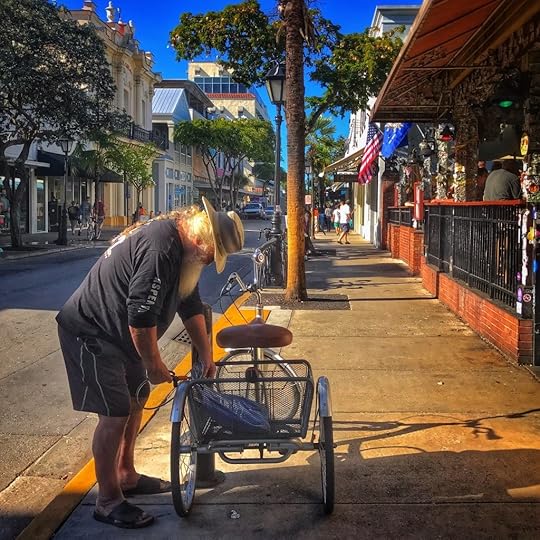


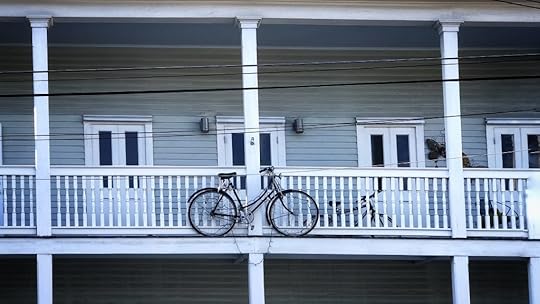

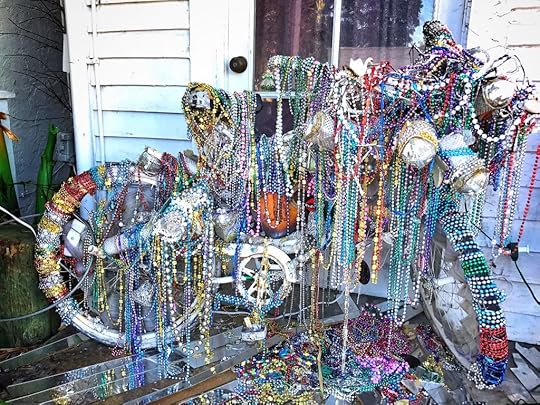





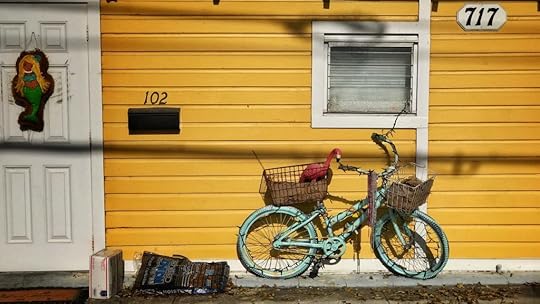
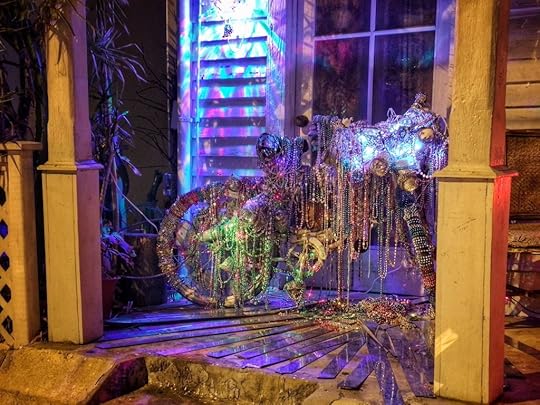
[All photos in this post are by Bill Carito. If you like them and want to see more, you can friend him on Facebook at https://www.facebook.com/bcarito and follow him on Instagram at billcarito and bill.carito.colorphotos.]
Save
Save
February 17, 2017
Weekend Update: February 18-19, 2017
 Next week at Maine Crime Writers, there will be posts by Barb Ross (Monday) Dorothy Cannell (Tuesday), Jen Blood (Wednesday), Jessie Crockett (Thursday) and Vaughn Hardacker (Friday).
Next week at Maine Crime Writers, there will be posts by Barb Ross (Monday) Dorothy Cannell (Tuesday), Jen Blood (Wednesday), Jessie Crockett (Thursday) and Vaughn Hardacker (Friday).
In the news department, here’s what’s happening with some of us who blog regularly at Maine Crime Writers:
From John Clark: I just had a short story accepted for an anthology edited by Kaye George that will come out this summer. The anthology title is DAY OF THE DARK (stories of eclipse) and my story set in the fictional town of Freeman, Maine is called “Relatively Annoying.”
From Vaughn C. Hardacker: I just heard from my publisher that ARCs of WENDIGO will be ready soon and the release date has been set as July 17, 2017.
An invitation to readers of this blog: Do you have news relating to Maine, Crime, or Writing? We’d love to hear from you. Just comment below to share.
And a reminder: If your library, school, or organization is looking for a speaker, we are often available to talk about the writing process, research, where we get our ideas, and other mysteries of the business. Contact Kate Flora
February 16, 2017
The Meaning of a Dining Room Table
As many of you know, I am a fourth generation antique dealer.
I was taught, by example and explanation, to value possessions not only because they were functional, but because they had been well designed and crafted. That, for example, furniture made of “real wood” was more beautiful, and would last longer, than modern commercial versions. That, in fact, such furniture might be worth more in the future, whereas “used furniture” would be worth little or nothing.
When I began furnishing my own home, I did it by attending auctions, and antique shows. Occasionally I’d buy something at a department store sale, knowing it would have to be replaced in the future. But I’m still using most of the furnishings and accessories I bought when I was in my twenties. Every thing I bought meant something to me: a moment, a history, or a style. Everything was bought to last.
Like many young people, my funds were limited. I first lived in a Greenwich Village apartment, where there was little space. I slept on an inherited convertible couch and one table from Macy’s was my desk, dining and kitchen table.
When, as a new adoptive parent, I bought my first house, a small Victorian with adjoining living and dining rooms, I used both spaces as sitting (and playing) areas.
I was single. When I had friends visit, usually other single adoptive parents, our children played together, and we ate buffet-style, balancing plates of Chinese food or pizza on our laps. Being single in suburban New Jersey meant I was not invited to dinner parties — they were for married couples — and I didn’t give them.
Secretly. the idea of hosting an elegant dinner intimidated me. Family Thanksgivings and Christmases I could manage. But other than that, my entertaining was casual, comfortable – and informal.
When my family grew, and my mother came to live with me for most of the year, I bought a larger home. This home had a living room, dining room, and “family room” as well as a kitchen on the first floor. I dealt with it as I had my smaller home — I made the spaces separate, but informal, living areas. No dining room or dining room table. If I needed table space for a large gathering, I lined up card tables and covered them with table cloths.
And then, when I was in my mid-forties, and had just survived the break-up of a serious relationship, I had a revelation. In my mind, dining rooms (and dining room tables) were for married couples. Grown-ups. The sort of people who had large weddings and were gifted china and sterling silver place settings. (Or, in more recent times, stainless steel.)
Somehow people like that knew how to cook large elegant meals, and had the accoutrements to serve them. And other couples to invite to share them.
They were grownups.
I was a corporate manager, the mother of four and the grandmother of one. My mother, my children and my granddaughter all lived with me. But I finally admitted to myself that in some ways I was still waiting to be part of a grown up couple.
As a feminist, I was angry with myself for feeling that way. And I declared my independence by deciding that I would buy a dining room table.
Of course, I wanted to find the perfect table — one that would last, and fit my life and my home. For several months I visited furniture stores and department stores. Most of the tables I saw were not made well, and few would fit into my traditional home. I also discovered that a dinning room table was a major investment. I was a single mom. I didn’t have thousands of dollars to spend on a table. I was saving for my kids’ education and my retirement.
I gave up looking for my table.
That July I went to Maine on vacation. Since I was an antique print dealer, my mother and I (and various of my children) often visited antique shops. That year we visited the nearby shop of a high-end dealer whose family had one shop in London, one in Maine, and who did the major New York shows every winter. Although he specialized in seventeenth to early nineteenth century furniture, he occasionally found prints, and had called my mother to tell her he had a set of Cries of London. (A series of early 19th century hand colored engravings showing street sellers “crying” their goods in London.)

My table, as a circular table seating four.
While we were there, of course, I checked out the dining room tables. And I fell in love.
The table I admired was, the dealer told, me, one he’d just purchased from the Booth Tarkington estate in Maine. A writer’s dining room table! It was mahogany; Queen Anne style. And it was special for several reasons. It was three pieces — a small center piece, with two sides that would fold down, so the (then) oblong table could be put against a wall. And two semi-circles that fit together, making a table large enough to seat four. The half circles would also fit against a wall independently– or the entire table could be assembled and would easily seat ten to twelve.
Because of its versatility it would fit in either an apartment or a large home.
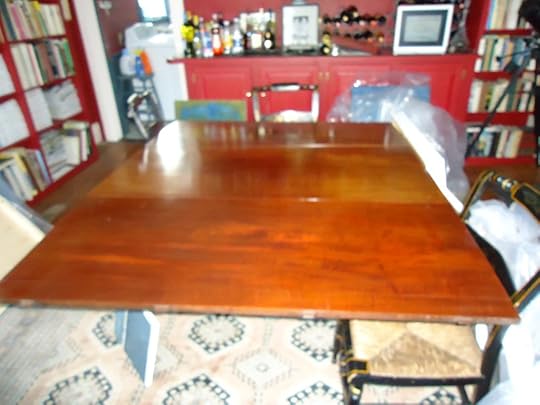
As a full table, leaves up, but without the semi-circular ends (that make up the round table.)
It was my table. Except for one thing. It cost four times as much as I had already determined to be too much to spend for a table. I admired it, drooled a little, and went home. (My mother and I did buy the Cries of London.)
Three days later I went back to visit the table. And then, a couple of days after that, I stopped in again. It haunted me. I dreamed about it.
And — a miracle happened. Each time I went back the dealer reduced the price to me. I didn’t even ask. He understood. And he knew I was a dealer. A single parent. A writer. And clearly I loved the table. But his price was still too high. The last week I was in Maine, visiting “my table” one last time, he threw up his hands. “It’s your table,” he declared. “I’ve had a good summer. I’ll take a tax loss on it if you can come up with … ” and he named the exact sum I had resisted paying for one of those modern tables I hadn’t liked.

Queen Anne legs …
I wrote a check on a line of credit for my antiques business. Two weeks later the table arrived in my New Jersey home. It is now in my home in Maine — part in the dining room, and part in the living room.
I never regretted it. That table was my proof to myself that I could be myself, successfully single, and grownup.
I’m not single anymore. And my husband and I do occasionally have dinner parties. It’s just as I had imagined. When we got married (at the town hall in Wiscasset with two witnesses) we decided to buy ourselves “wedding china” — which we did, piece by piece — so we now can serve guests in our own version of elegance.
Many books today suggest how to down size, and get rid of unwanted or unneeded possessions. Yes, we all have those.
But when you have the perfect table, it will stay. I hope I’ll live in this house for the rest of my life, but, if for some reason I don’t, that table will go with me.
It’s not just a table. It’s a symbol, of growing up, and accepting. And believing that what you really want and will work for, can be yours.
February 15, 2017
Seeing Red
Kate Flora: When I was working on my last Joe Burgess, Led Astray, I noticed that I  was using the weather, in particular the mysterious qualities of fog, and the discouraging chill and damp of a string of gray Maine days, to underscore the struggles of the central characters to find their way through a maze of lies, confusion, and lack of information to head off a killer before there was a full-on disaster. Once I noticed that I was using all these grays—and darkness punctuated by small bits of light—to create my atmosphere and mimic my characters’ challenge, I continued it throughout the story. The story began on a gray afternoon and the sun did not come out in Portland until the bad guy was caught.
was using the weather, in particular the mysterious qualities of fog, and the discouraging chill and damp of a string of gray Maine days, to underscore the struggles of the central characters to find their way through a maze of lies, confusion, and lack of information to head off a killer before there was a full-on disaster. Once I noticed that I was using all these grays—and darkness punctuated by small bits of light—to create my atmosphere and mimic my characters’ challenge, I continued it throughout the story. The story began on a gray afternoon and the sun did not come out in Portland until the bad guy was caught.
Most of the time, we do this work on both a conscious, and an unconscious level as we’re crafting story.

A single bright red boat on a summer sea
I was thinking of that recently when I opened up a coffee table book that belonged to my late sister-in-law Emily, who lived in the world of fabric and fashion. The book was from an exhibit at the Cooper-Hewitt, and the title was Fashion in Colors. As I leafed through the book, my eyes lit on a section called “The Two Faces of Red.” Red, the curators had observed, is a word with many powerful meanings.
There are words like crimson and vermillion, which suggest elegance and opulence. There

Orange-red roofs of a Czech village
are the red garments worn by Cardinals of the church. In these ways, the book suggests, “red endows a sense of the brilliant, dazzling, magnificent, or simply beautiful.”
On the other hand, red has negative implications as the color of executioners or prostitutes
—scarlet women. Red light district. The color of anger—as in “seeing red,” and “an angry red haze.”
And sometimes, over time, the early symbolism changes. During the French Revolution, a red flag signaled “the intervention of public forces to disperse seditious crowds.” Now, far from suggesting the assertion of public order, it is a sign that something wrong has taken place or should be investigated.

The warmth of sunset on Utah’s red rocks
Wikipedia says: Since red is the color of blood, it has historically been associated with sacrifice, danger and courage. Red is also the color most commonly associated with heat, activity, passion, sexuality, anger, love and joy. In China, India and many other Asian countries it is the color of symbolizing happiness and good fortune. In the United States, red pertains to the Republican Party and its supporters. Red is also a color widely used for getting attention, such as stop signs or royal dresses. In addition, red is widely associated with socialism and communism.
For writers looking to play with symbolism in their work, consider this. In Victoria Finlay’s  book, Color, we learn that the shade of red paint called “carmine” was actually made from blood. Before the advent of artificial dyes which revolutionized the dying and fabric industries, red often came from the crushed shells of cochineal beetles or a beetle that lived on the Scarlet Oak called the kermes beetle.
book, Color, we learn that the shade of red paint called “carmine” was actually made from blood. Before the advent of artificial dyes which revolutionized the dying and fabric industries, red often came from the crushed shells of cochineal beetles or a beetle that lived on the Scarlet Oak called the kermes beetle.
The red in the rocks of the Southwest comes from iron, as does the red in our blood. If you take a few minutes and a sheet of paper, you can probably come up with a long list of words for the many shades of red. Then take the time to consider how different these words feel. Consider scarlet vs. burgundy. Let your senses go from the richness of vermillion or crimson to the softness of cherry or rose; from the brightness of cardinal to the subdued darkness of maroon. The exotic suggestion of cinnabar or cerise. The gemlike qualities of ruby or garnet. We readily use the terms “blood red” and “fire engine red.”

The gentle colors of a December rose
As the weather outside persists in the white of snow, the gray of ice, and the dull gray-browns of leafless trees, this is a good time for writers—and observers—to be playing with color. It doesn’t have to be red. How many words for the color gray can you think of? Iron gray, steel gray, battleship gray, pearl gray, slate gray. How many more might you add if you played with your dictionary or your thesaurus? Where might inspiration take you if you played with this a bit?
Finding Redemption in a small Maine town

The ever capable Ben holding up the building.
John Clark sharing insights into a business many of us use regularly, but may not know much about. Do you buy beer, wine or soda? Chances are you do and after consuming the contents, it’s time to recycle the container and get your deposit back. In urban areas you usually have a number of options, but get into the country and sometimes taking them back involves a trip.
Since we moved to Hartland in 2003, we’ve seen six open and five close. Today, I’m going to have you meet Joe and Vicki Tuttle, owners of DUDOS on Pittsfield Avenue in Hartland. After the last redemption center closed, I saved my returnables until I had other reasons to go to Newport. Doing so involved driving 12 miles round trip-not exactly convenient. I noticed the new place when I was on my way to Pittsfield and decided to give it a try. I’m very glad I did. Most of the redemption centers in our area have been fairly messy and not well heated. DUDOS in both clean and warm as well as run by extremely friendly people.
Last week, I chatted with Joe and Vicki for more than an hour. Joe grew up in Athens, the next town over, so he knows the area pretty well. They bought a house up the road from where we live after deciding to locate to a place convenient to their regular jobs. Joe drives truck for Linkletter in Athens, Vicki waitresses in Newport, so a place on the Athens Road in Hartland is ideal. Ask anyone who drives big rigs and they’ll tell you that driving truck is hard on your body. With that in mind, Joe started thinking about a way to boost income and better plan for retirement. Opening a redemption center wasn’t on the radar in the beginning, but the place they looked at had been one in the past, so he and Vicki connected the dots and DUDOS was born.
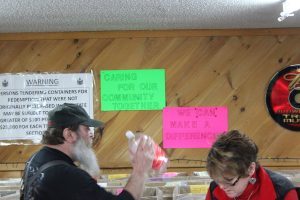
Joe and Vicki hard at work.
When you walk in, you’re greeted by light and smiling people. Two large stainless steel sinks are in place so multiple customers can have returnables sorted simultaneously. Ben Bernard, who worked at the last redemption center in Hartland brought his solid work ethic, knowledge of sorting and his customer service skills with him, something both Joe and Vicki appreciate.
Vicki came up with the name DUDOS which comes from her liking to create acronyms. In this case it stands for Drink Up, Drop Off, Sober. A friend is in the process of making a large sign in the shape of a moose to go out front with the acronym explained in the middle of the sign.
I asked plenty of questions and got some interesting and insightful answers. They noted that anyone planning to start a redemption center needs to have money up front. This is needed not only for equipment and supplies, but there’s a time lag of 1-2 months between the time you start paying out to customers and when you start receiving payment from the distributors. Having consistent hours open and sticking to them is critical. This has been the downfall of several nearby redemption centers in recent years.
I was surprised to learn that licensing isn’t a big hassle. Vicki said it’s handled by the Department of Environmental Protection (DEP) and the biggest concerns they have are safe and proper drainage and a level of cleanliness that reduces the possibility of pests. You also need to have a sign posted notifying patrons that trying to redeem containers purchased out of state is punishable by a fine. DEP is also willing and able to step in if and when a vendor doesn’t pick up returnables from their products in a timely manner.
The actual process of accepting, counting and sorting returnables involves preparation. While some containers can be mixed (two or three brands handled by the same distributor, getting it right so you don’t have to re-sort too frequently means buying, assembling and labeling lots of tall cardboard boxes and then opening and inserting big plastic bags. Then when things get hectic, you need to remember which gets tossed into what box. When Joe, Vicki and Ben are firing on all cylinders, you can get dizzy just watching cans and bottles fly. At times the tossing is so furious that things collide in midair and end up in the wrong bin. Each bag when filled contains as many as 324 cans. When I asked about volume, Joe said they often sort, count and fill upwards of 70 bags a week (that comes out to over 20,000 returnables every week)

Imagine filling 70 of these a week. That adds up to over 3600 per year.
Thinking about starting your own redemption center? Here are a few suggestions from Joe. Spend some time working or volunteering at one that’s already up and running. Nothing is as good as a little hands-on experience. Make sure you have adequate storage space and decent plumbing. One comment heard over and over at DUDOS is how clean and how good the place smells. Don’t be cheap when it comes to a sorting sink. Joe suggests one that’s at a height that is kind to your back is connected to your drainage system and isn’t too deep. He got a really good deal on a second one from a restaurant that closed. Be willing and able to refuse visibly dirty or contaminated containers. Redemption centers have a legal right to do so. Not long after opening, they had a customer who brought in a big bag that had soiled disposable diapers in with the bottles. Being a people oriented person is also a huge plus.
Joe and Vicki have a real interest in Hartland. They have been involved with the annual Childrens’ Christmas Fund for kids. Customers can donate their returnable money to that fund as well as to the town fire department and the Somerset Humane Society. DUDOS encourages local bottle drives and pays an extra cent per container when what has been collected gets dropped off. The center is open Wed. & Thurs. from 10-4, Saturday 9-4 and Sunday 10-3. We’re fortunate to have DUDOS serving the Tri-town area.
February 13, 2017
VAGARIES OF THE ENGLISH LANGUAGE
Susan Vaughan here. Yes, it’s Valentine’s Day, but my topic is far from hearts and flowers. If you hate grammar, you have my permission to read no further. For this post is about changing and meandering usage and spelling in English. Although I taught seventh grade language arts for eight years once upon a time, I did not major in English, but have long enjoyed the peculiarities of the language.
The English language began and developed over a thousand years into the tongue we speak and write today. Invasions by the Angles, Saxons, and Jutes brought its beginnings to England. Christianity brought by St. Augustine and his followers introduced Latin and Greek influence, and the language was further transformed by the French-speaking Norman conquest. Many words used in courtrooms today derive from Old French—attorney, bailiff, defendant, jury, mortgage—to name a few. If you’ve ever wondered why English is so hard to spell and has so many variations, as well as silent letters, you have all those invasions to blame.
Living languages change and grow with new discoveries, new technologies, new immigrants, wars, and wider communication. One example is something I read often in novels and hear and read daily on various media by the media.
MEDIA. According to grammarphobia.com, the word media is considered a plural noun and should take a plural verb, as in “The media are all agog over the latest Tweets.” Radio is a medium of communication, TV is a medium, and together they are media. But of course, language changes, and given the daily misuse, it won’t be long before media will be considered acceptable by all as plural.
[image error]ALL RIGHT VS ALRIGHT. The spelling variation (or error, depending on your viewpoint) alright has been creeping into informal writing since the 1980’s. I’m convinced that when Pete Townshend wrote “The Kids Are Alright” for The Who, he simply made a spelling error. And today in informal writing, you’ll see alright, but it should never appear in edited text, according to Dictionary.com. At least for now.
ALL OF A SUDDEN VS ALL OF THE SUDDEN VS ALL THE SUDDEN. All of a sudden may not seem grammatical now—many idioms defy rules—but at one time sudden was a noun, derived from the Latin into the Anglo-Norman French sudein, and becoming sudden in the 1500s. All of a sudden is an idiom that has been in the vernacular for a long time. But how did we get the alternate forms?
All of the sudden and all the sudden started popping up in the 1980s as slang variants, and with the advent of social media have become more prevalent. Maybe in another hundred years, the new options will be the standard, but according to Motivated Grammar, all of a sudden is the standard idiom in contemporary English.
FARTHER/FURTHER. These are words that both mean “at a greater distance,” but have gone different directions on either side of The Pond. In the U.S., farther is most often used to refer to physical distances, and further to refer to figurative and nonphysical distances. I might say, “Moosehead Lake is farther away from me than Damariscotta Lake,” and “Before we go any further, how much further has your investigation gone, and has the suspect run any farther?” In the British Commonwealth, further is preferred for all senses of the word.
AWESOME/DECEMBER/DECIMATE. Sometimes words stray from their roots. Awesome originally meant “deserving of awe,” and awful to mean full of awe. The Latin root decem means “ten, but December is our twelfth month. The same discrepancy crops up for September, October, and November because the ancient Roman calendar had only ten months in the year. Two more were eventually added, shifting the numbering but not the words.
Decimate also contains that pesky root meaning “ten,” and originally meant “killing a tenth of the enemy’s soldiers” or “taking the tenth” or a tithe. Merriam-Webster also includes the meanings that we hear most of the time now: “to reduce drastically in number (Spraying decimated the mosquito population.) and to cause great destruction or harm (Carpet bombing decimated the city.).”
Detours and developments in English have many causes, perhaps more in the 21st century than in the past. We are a more diverse society. Grammar is not being taught as rigorously, partly because of so much more that must be covered in school at all levels. More slang is creeping into our speech and writing from TV and other media. Speech in general is less formal than in many previous generations. The greatest and fastest changes may stem from the speed of technological development and the availability of communication and prevalence of travel today. Our English language is changing almost daily.
Does anyone else find it hard to keep up? Does anyone have a new word or phrase to mention or an old one that you see/hear changing?
February 12, 2017
Nostalgia For Fun And Profit
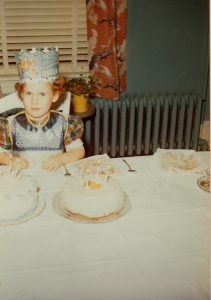
dining room in 1951
Kaitlyn Dunnett/Kathy Lynn Emerson here. As readers of this blog know, I’ve been working on the first in a new series (Crime and Punctuation, a Deadly Edits Mystery) to be published in June 2018, in which the widowed retiree sleuth returns to her old hometown after fifty years away. Since I’m a firm believer in making things easy on myself, I’m using a lot of bits and pieces of my own life as fictional fodder. In particular, the house Mikki Lincoln grew up in, and which she has now bought back, is the house I lived in from 1951 until I went off to college in 1965. Although I have no obligation, since I’m writing a novel, to stick to the reality, it’s kind of neat to have that floorplan in my head, along with the memory of some of the changes my folks made to the place while they owned it.

the back of the house with the dining room window behind the tree
Part of my “research” for this project, in addition to a trip back to the old hometown for my own fiftieth high school reunion, has consisted of digging out old memorabilia and the many, many photographs and home movies my father took when I was a kid. They include interior shots of several rooms in our house.
Without giving away too much of the plot, several crucial scenes take place in the dining room Mikki is using as a temporary office for her free lance book editing business. There are confrontations, discoveries, quiet chats between Mikki and her calico cat, and one scene where a clear concept of the size of that room is crucial. Yes, I could make the room as big as I like, but it just so happens that I have lots of photos of the dining room.
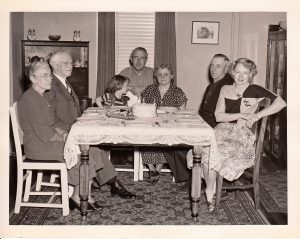
1952
It’s fun to reminisce, both as myself and when I’m in Mikki’s head. Naturally, since we are the same age and with similar backgrounds, she has many of the same memories I do, as does her friend Darlene. And, like me, they occasionally have trouble remembering elusive details. Looking at old photographs helps fill in the blanks, but there has been another benefit too.
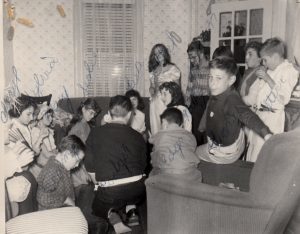
1959
I’ve been sharing some of my favorite finds on Facebook for “Throwback Thursdays” and also posting them on a Facebook group founded to exchange news and reminisce about the old hometown. That connection has led to even more sharing of nostalgic memories and then, to make the circle complete, several of those exchanges have called up a ton of descriptive details I’m using to make my writing more vivid.
All characters in Crime and Punctuation, naturally, are entirely figments of my imagination. The girl or boy who grew up to be a (insert profession here) would never have committed murder!!! And that  kid who appears in every single photograph? The one her sixth grade yearbook predicted would become a muscle woman in the circus? She’s still living in rural Maine with her husband and her cats and has no intention of moving back to New York State, not even if her old house does come up for sale.
kid who appears in every single photograph? The one her sixth grade yearbook predicted would become a muscle woman in the circus? She’s still living in rural Maine with her husband and her cats and has no intention of moving back to New York State, not even if her old house does come up for sale.
P.S. As I’m scheduling this, the weather forecast for Monday includes over twenty inches of snow and high winds for this part of Maine. If you leave a comment (and I hope you will) I may not be able to respond right away.
February 10, 2017
Weekend Update: February 11-12, 2017
 Next week at Maine Crime Writers, there will be posts by Kaitlyn Dunnett/Kathy Lynn Emerson (Monday) Susan Vaughan (Tuesday), John Clark (Wednesday), Kate Flora (Thursday) and Lea Wait (Friday).
Next week at Maine Crime Writers, there will be posts by Kaitlyn Dunnett/Kathy Lynn Emerson (Monday) Susan Vaughan (Tuesday), John Clark (Wednesday), Kate Flora (Thursday) and Lea Wait (Friday).
In the news department, here’s what’s happening with some of us who blog regularly at Maine Crime Writers:

The beautifully renovated Lithgow Public Library in Augusta
Maureen Milliken will be speaking at Lithgow Public Library’s Meet the Author event from 1-2:30 p.m., Thursday, February 16. The talk will feature her infamous “Questions Readers Ask” slideshow! Come on up and say hi. She’ll have books available for selling and signing.
The library was renovated with a huge addition last year, and it’s worth the trip just to see what they’ve done.
An invitation to readers of this blog: Do you have news relating to Maine, Crime, or Writing? We’d love to hear from you. Just comment below to share.
And a reminder: If your library, school, or organization is looking for a speaker, we are often available to talk about the writing process, research, where we get our ideas, and other mysteries of the business. Contact Kate Flora
February 9, 2017
The TV cops shows of our childhood made us writers. Solid.

The weather outside is frightful. That’s why we’re inside.
Well, the weather outside is frightful, but the TV is so delightful…
That’s right, folks. As the snow and wind howl outside, those of us who don’t have the luxury of jetting off to the tropics to escape the Maine winter often hole up at home with a nice warm TV. Or these days, iPad or other streaming device. Yes, reading a book on a nasty winter day is also devine, but sometimes there’s nothing like finding a good old comfortable show to watch.
Today I took a break from writing and stuff to watch some of my favorite episodes of The Mod Squad. Don’t laugh, I find them comforting and still hugely entertaining nearly five decades after I first started watching the show.
Now, in the 21st century, we’ve been pretty lucky to see crime TV elevated to storytelling heights we’d never thought possible. After watching The Wire and other shows like it, or fantastic British series on Netflix like Broadchurch and Happy Valley, it’s hard to believe we were so enthralled by the cop shows of our youth.
I’m not talking about the shows that began to change the whole cop show genre that began coming out when I was a teen and in my 20s — Hill Street Blues, Police Story, Homicide: Life on the Street (the precursor to The Wire). I’m talking about the shows seeped in 1960s and early 1970s kitsch. You know what I’m talking about. Watch them and cringe, right? But I still find a lot of value in some of those shows, despite how dated they are. And on top of it, in a lot of ways they helped me develop into the storyteller I became, part of the foundation that’s allowed me to take a mystery series into two books, with another in progress and hopefully a lot more to come, if what’s going on in my head is any indication.
A recent discussion my sister Rebecca Milliken and I had about our favorite old cop shows on our podcast, Crime & Stuff, along with the death of Mike Connors last week (Mannix!) has me thinking a lot about those old shows and what they gave me.
Even as I child I think I was fascinated by character development. One of the main things I remember about Mannix is his secretary, played by Gail Fisher, nursing his wounds after he was beat up yet again. Fisher was a breakthrough on TV — a black woman playing second fiddle to the white PI.

Mike Connors and Gail Fisher made a great pair on Mannix
While TV wasn’t yet progressive enough to have them have a full-blown relationship, even as a kid I could see there was something special between them. She was nurturing, yet stern. In a lot of ways playing the role a cool wife would play.
I admit, as a pre-teen I found Mike Connors’ craggy good looks compelling, but I think that relationship is what made the show so much more interesting than some others of its time.
The Rockford Files is another one that stood out. James Garner was always so great at self-effacing humor, and his anti-hero and the wry commentary that he provided gave the show a layer of character that many shows didn’t have. Garner, as he did in most movies he was in and his other great TV show, Maverick, always delivered his lines with that half-grin that told you he wasn’t taking any of it too seriously. Which gave the serious moments a lot more power.
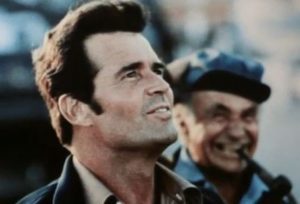
James Garner and Noah Berry on The Rockford Files.
Even the opening sequence, which always started with someone leaving a message on his answering machine, signaled that the show was not taking itself too seriously. Those messages were often ironic or funny, even to a 12-year-old. His exasperating relationship with his father, played by Noah Berry, was something you couldn’t find on another show.
Rockford Files was definitely not a police procedural, but a human study with the usual car chases and shoot-em ups added in because that’s what those shows had to have in those days.
But my favorite was The Mod Squad. The relationship between Pete, Linc and Julie, the fact that while there were plenty of car chases, foot chases and fights, they never used guns, the fact that they were outsiders and often treated like such, appealed to me as a child.

Linc, Pete, Julie and Captain Greer. Best of friends and crime-fighters too. (Clarence Williams III, Michael Cole, Peggy Lipton and Tige Andrews)
I’d go to bed and rewrite that week’s episode in my head, putting myself in the scenes, of course. I’d go over and over, trying to get dialogue right, or make a scene come out a certain way. I wasn’t just a budding writer, but a budding editor! Or maybe just a little nuts. But aren’t we all?
Sure, it was a cliche that Julie was always getting abducted, but just like the fact they couldn’t come right out and say Linc was the leader, even though it was obvious he was, it was the 1960s and early 1970s and there were social mores that just…were.
Still, the fact Linc WAS the leader — cool and composed, the one Captain Greer always turned to in times of crisis — was pretty cool. How easy it would have been to make Pete the leader. But Pete was too emotional, and often had to be reigned in by Linc (“Pete, stop, you’re gonna kill him!”). The co-protagonist of my Bernie O’Dea mystery series, Police Chief Pete Novotny, is kind of a homage to Pete Cochran, though their personalities are different. He may have a little Linc in him, too. That character started developing in my head back when I was 9 or 10 and rewriting Mod Squad episodes in my head.
The best thing about the show was that the three main characters cared deeply about each other, and their gruff Captain Greer, too. I’m sure that’s why I loved the show and kept watching, and that’s one of the reasons I like to rewatch them today, despite how dated some aspects are.
Writers aren’t born in a vacuum. The writer and storyteller we become has its roots in the influences that began as soon as we became aware of the world around us. As soon as we could see and hear, then start analyzing what we saw and heard and start making sense of it as far as our own reality went. Obviously, what we read throughout our lives was a huge influence. But don’t discount those old TV shows for those of you who, like me, are part of the TV generation.
Glad to realize those hours sitting in front of that black and white TV, that we had to use a pair of pliers to change the channel with after the knob broke off and hit to make the picture stop jumping amounted to something.
I could go on and on, but it’s snowing like hell out and I should be writing. Or maybe watching just one more episode of The Mod Squad. Don’t get uptight, man. It’s cool. Solid.
EVENT: Maureen will speak at Lithgow Public Library in Augusta, Maine, from 1-2:30 p.m., Thursday, February 16. She’ll have books available for signing and selling. Come on up and say hi!
Maureen Milliken is the author of the Bernie O’Dea mystery series. Follow her on Twitter at@mmilliken47 and like her Facebook page at Maureen Milliken mysteries. Sign up for email updates at maureenmilliken.com. She hosts the podcast Crime&Stuff with her sister Rebecca Milliken.




